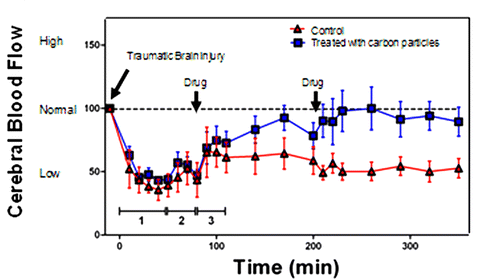New advance could help soldiers, athletes, others rebound from traumatic brain injuries

A potential new treatment for traumatic brain injury (TBI), which affects thousands of soldiers, auto accident victims, athletes and others each year, has shown promise in laboratory research, scientists are reporting. TBI can occur in individuals who experience a violent blow to the head that makes the brain collide with the inside of the skull, a gunshot injury or exposure to a nearby explosion. The report on TBI, which currently cannot be treated and may result in permanent brain damage or death, appears in the journal ACS Nano.
Thomas Kent, James Tour and colleagues explain that TBI disrupts the supply of oxygen-rich blood to the brain. With the brain so oxygen-needy—accounting for only 2 percent of a person's weight, but claiming 20 percent of the body's oxygen supply—even a mild injury, such as a concussion, can have serious consequences. Reduced blood flow and resuscitation result in a build-up of free-radicals, which can kill brain cells. Despite years of far-ranging efforts, no effective treatment has emerged for TBI. That's why the scientists tried a new approach, based on nanoparticles so small that 1000 would fit across the width of a human hair.
They describe development and successful laboratory tests of nanoparticles, called PEG-HCCs. In laboratory rats, the nanoparticles acted like antioxidants, rapidly restoring blood flow to the brain following resuscitation after TBI. "This finding is of major importance for improving patient health under clinically relevant conditions during resuscitative care, and it has direct implications for the current [TBI] war-fighter victims in the Afghanistan and Middle East theaters," they say.
More information: "Antioxidant Carbon Particles Improve Cerebrovascular Dysfunction Following Traumatic Brain Injury", ACS Nano, 2012, 6 (9), pp 8007–8014. DOI: 10.1021/nn302615f
Abstract
Injury to the neurovasculature is a feature of brain injury and must be addressed to maximize opportunity for improvement. Cerebrovascular dysfunction, manifested by reduction in cerebral blood flow (CBF), is a key factor that worsens outcome after traumatic brain injury (TBI), most notably under conditions of hypotension. We report here that a new class of antioxidants, poly(ethylene glycol)-functionalized hydrophilic carbon clusters (PEG-HCCs), which are nontoxic carbon particles, rapidly restore CBF in a mild TBI/hypotension/resuscitation rat model when administered during resuscitation—a clinically relevant time point. Along with restoration of CBF, there is a concomitant normalization of superoxide and nitric oxide levels. Given the role of poor CBF in determining outcome, this finding is of major importance for improving patient health under clinically relevant conditions during resuscitative care, and it has direct implications for the current TBI/hypotension war-fighter victims in the Afghanistan and Middle East theaters. The results also have relevancy in other related acute circumstances such as stroke and organ transplantation.
Journal information: ACS Nano
Provided by American Chemical Society















